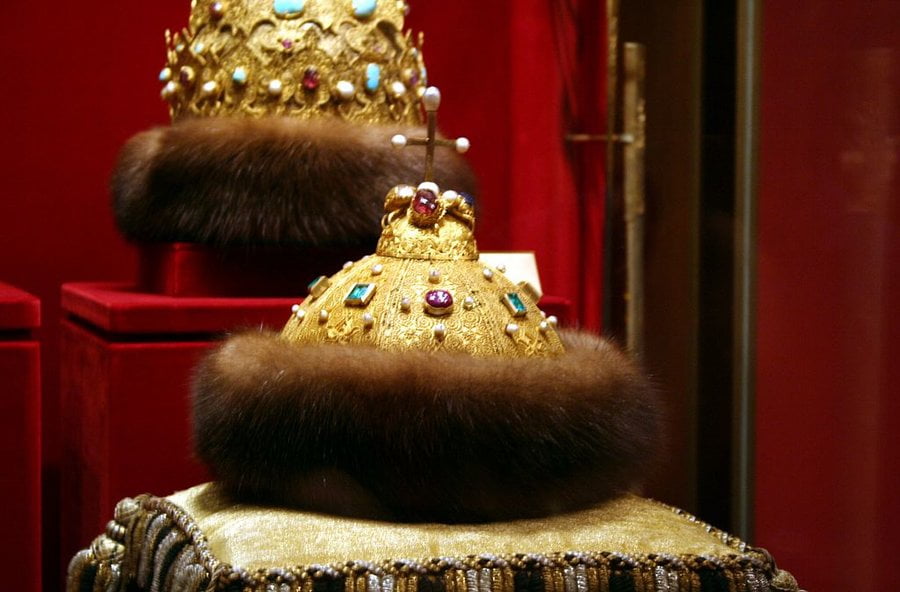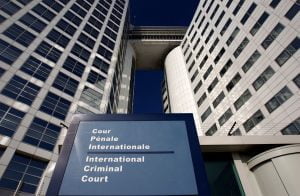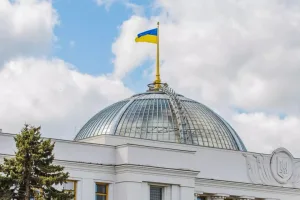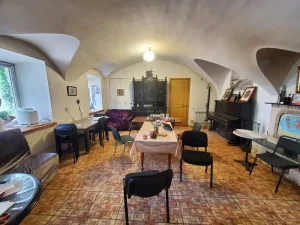Many English people will know of the old Saxon Kingdom of England, Alfred the Great and his ancestors, the Kingdom of Wessex ruled by the ancestors of a semi mythological Cerdic (“Cerdicingas” in the old English) and the defeat of Harold Godwin(e) at the famous Battle of Hastings in 1066. Those of us who also know something of old Kyivan Rus, ruled by the ancestors of the semi mythological Rurik/Rørikr (the “Rurikids” as historians call them), the Varangian, or the Viking traders and raiders who went East from what is today Sweden and became Princes of Novgorod and then founded the Kingdom/Grand Principality of Kyivan Rus. We heard of Putin’s claim to the long relationship between Muscovy and France last year when he spoke of “Anna of Russia” who married King Henri l of France in 1051. History knows no “Anna of Russia”, Moscow did not exist at the time and the “Anna” he mentioned is known as “Anna of Kyiv”, one of the daughters of the Prince Yaroslav the Wise (Jarizleifr Valdamarsson or Jarisleif the Lame in old Norse), Grand Prince of Kyiv who among other things made the first Kyivan Rus code of law (the Russkaya Pravda), built the ‘Golden Gate’ of Kyiv and during who’s reign the current Ukraine trident/Tryzub first appeared on coins.

The first appearance of the Tryzub on the coins of Yaroslav the Wise.
What many do not know is the far flung links, marriages and alliances between not only the Saxon Kings – both the ancestors of Cerdic and those of Godwin(e) with the ancestors of Rurik but even of English settlement in what is now Ukraine. Here I shall recount a little of story. This may get complicated but I will provide a full list of Wikipedia links to all people mentioned at the end. Please refer there if you get lost as there quite a few names.
1. The Exiled Princes.
To put the fist visit of English Princes to Kyiv a little context is required and story begins with an unhappy time in Anglo Saxon English history during the reign of the King known today as “Æthelred the Unready” who ‘ruled’ (or misruled) Old England from 978AD to 1013AD. He was the Great Grandson of Alfred the Great but as his name implies inherited little of his Great Grandfathers wisdom. In old English his nickname “Unræd” does not mean ‘unready’ in the modern sense bad rather “Redeless” from the same source as his name æðele, “noble”, and ræd, “counsel, advice” so literally speaking his name translated would mean “Noble counsel, No counsel”, in other words his nickname was an amusing play of words at the time. From this unfortunate King also derived Anglo Saxon Englands later Norman problems since his second marriage was to Emma of Normandy, she being the daughter of Richard I (known as “the Fearless”) of Normandy, a grandson of Rollo, the leader of the first Vikings who settled in what was to become Normandy in 918AD.
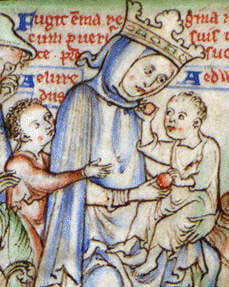
Queen Emma fleeing to Normandy with her sons – one being the future Edward the Confessor.
William, the ‘Bastard’ also known as “the Conqueror” who defeated Harold Godwin(e)son at Hastings in 1066 derives his claim from the second marriage of “Æthelred the Unready” to Emma of Normandy in 1002AD. During the latter part of Æthelred’s reign Sweyn Forkbeard, King of Denmark forced him into exile – in Normandy. Sweyn briefly ruled England but died five weeks later.
When Sweyn died Æthelred briefly returned to rule (or misrule) but had problems with his own son (by his first marriage) Edmund ‘Ironside’ and with Sweyn’s son Cnut. The unfortunate King died in London on 23 April 1016AD and was succeeded by his son (through his first marriage to Ælfgifu of York) Edmund ‘Ironside’ who resumed the war against Sweyn’s heir Cnut. For a time Edmund forced a truce but the hope of Saxon England ended with his short rule on 30 November 1016AD. Edmund’s half brother, the future Edward the Confessor, being then 13, Cnut “The Great” was made King of England and for a brief time ruled a “Northern Empire” ruling England, Denmark and Norway marrying the widow of Æthelred – Emma of Normandy.This is the context into which enter the story of the lost Princes – the sons of Edmund ‘Ironside’.
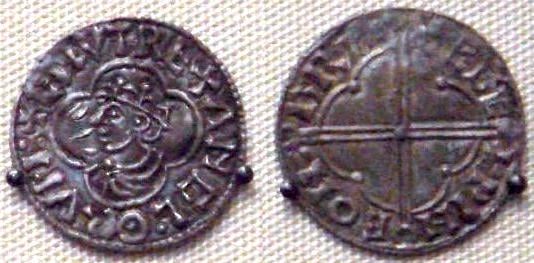
Coins issued by Cnut emphasising his Christianity.
When Sweyn died Æthelred briefly returned to rule (or misrule) but had problems with his own son (by his first marriage) Edmund ‘Ironside’ and with Sweyn’s son Cnut. The unfortunate King died in London on 23 April 1016AD and was succeeded by his son (through his first marriage to Ælfgifu of York) Edmund ‘Ironside’ who resumed the war against Sweyn’s heir Cnut. For a time Edmund forced a truce but the hope of Saxon England ended with his short rule on 30 November 1016AD. Edmund’s half brother, the future Edward the Confessor, being then 13, Cnut “The Great” was made King of England and for a brief time ruled a “Northern Empire” ruling England, Denmark and Norway marrying the widow of Æthelred – Emma of Normandy.This is the context into which enter the story of the lost Princes – the sons of Edmund ‘Ironside’.
Edmund ‘Ironside’s’ two infant sons, Edmund Ætheling (literally meaning “noble born” but also used to denote “Princes of the Blood” in old English) and Edward “the Exile” (also an “Ætheling”), consituted no immediate threat to Cnut. When their Father died the eldest, Edmund (though they may have been twins), was just over a year old possibly (the dates of their births are uncertain) but they did represent a long term problem and possibly a future threat for other English Saxons would surely recognise their claim as royal Princes. Cnut therefore had the two young children sent to Denmark where Cnut’s own half brother Olof Skötkonung reigned. It is likely that Cnut wished that Olof would get rid of the two young Anglo Saxon Princes for him. If so this plan miscarried. Somehow, by luck or by design but by the will of God (Olof having converted to Christianity as did Cnut), the two Princes ended in Kyiv where Olof’s daughter, Ingegerd Olofsdotter of Sweden “Irene” in Greek also known as “Saint Anna” was married to Yaroslav the Wise/ Jarizleifr Valdamarsson. It was “Saint Anna”/Irene/Ingegerd Olofsdotter of Sweden who initiated the building of Saint Sophia’s Cathedral in Kyiv which accounts for her later being proclaimed a Saint.

Edmund Ironside in a later depiction.
In the Kyiv of Yaroslav the Wise and his Wife Saint Anna the two young Anglo Saxon Princes found harbor and grew up. In 1039AD, by which time Edmund and Edward would have been 21-23yrs old, Anastasia of Kiev (the eldest daughter of Yaroslav the Wise and Saint Anna and sister of Anna of Kiev who married Henri l of France) married Duke (later King) Andrew of Hungary. Thus Yaroslav made an alliance with a claimant to the Hungarian Crown and when Andrew returned to reclaim Hungary, defeating Peter l of Hungary also known as “Peter the Venetian” in 1046AD. Doubtless Yaroslav the Wise sent other help with Duke, later King, Andrew l (known as “the White”). Princess Anastasia of Kiev, by then already married to Andrew for some time and the two Anglo Saxon Princes went with the future Hungarian King.
Why the young Æthelings went with the then Duke Andrew and Princess Anastasia we cannot know. Perhaps Yaroslav wanted rid of them. Perhaps they were attatched to the Princess Anastasia who was some seven or eight years younger than them having been born in 1023. Perhaps Andrew offered them reward if he managed to gain to throne. Perhaps all three. Another theory is the elder of the Brothers, Edmund, disgraced himslef by having an affair with a noble Lady in the 1030s and had been “frozen out” by Yaroslav leaving Edward as Yaroslav’s confident and adviser on Anglo Saxon affairs. This may account for the unknown origin of Edward’s Wife. We know that the elder brother Edmund married a Hungarian Princess but the daughter of which Hungarian King is not recorded. Shortly after this marriage Edmund died in Buda. His Brother Edward married a certain Agatha. Who this Agatha was remains a mystery; there are German, Hungarian, Bulgarian, Polish and Kyivan theories. It is possible she was a daughter of Yaroslav and Saint Anna and if Edward’s closeness to Yaroslav the Wise after the shame of his Brother for some affair is to be believed then it may gain credence but the simple fact is we do not know her lineage, though royal it must have been as the two Princes were valuable diplomatic assets and clearly treated well during their exile in Kyiv and Buda. By this unknown Agatha Edward, known as “the Exile” had three children; Edgar known as the Ætheling, Margaret – who would become known as “Saint Margaret of Scotland” and Cristina who became an Abbess devoted to the Holy Order of Saint Benedict.
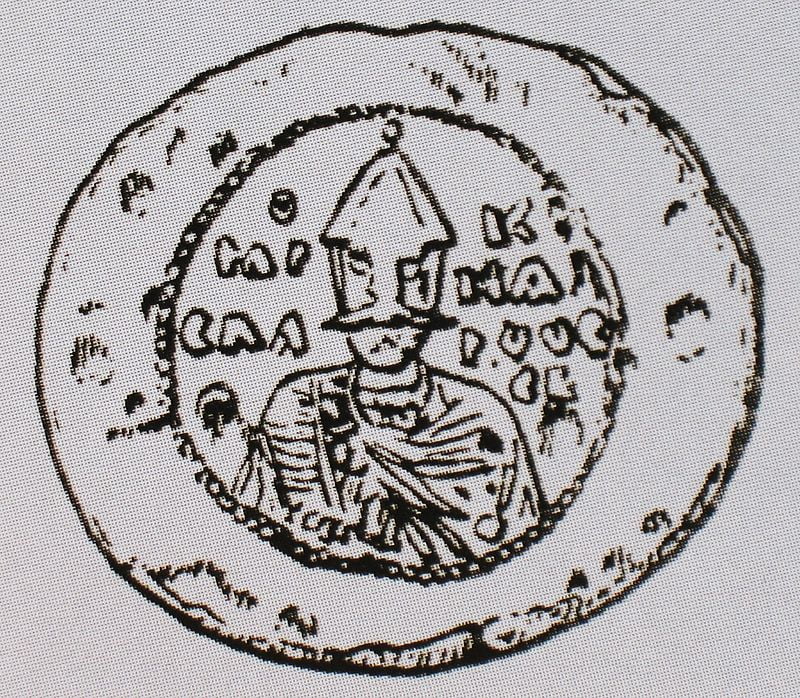
The Seal of Yaroslav the Wise who harbored the English Princes.
Meanwhile in England times had moved on as well. Cnut died in November 1035AD and left two sons, one by his first Wife (Ælfgifu of Northampton, the widow of Edmund ‘Ironside’) known as Harold Harefoot and a second by his second Wife, the widow of Æthelred, Emma of Normandy known as Harthacnut. Harold Harefoot was in England at the time of Cnut’s death probably due to his having an English Mother was proclaimed King. Cnut’s late Wife, Emma of Normandy, the Mother of both Harthacnut (by her second marriage to Cnut) and the later King Edward “the Confessor” did not take this well and her sons by “Æthelred the Unready” (Ælfred Ætheling and Edward later known as “the Confessor”) both raided England in 1036. Harold Harefoot’s half Brother Harthacnut was also established in Denmark and war with him seemed likely. It should perhaps be mentioned that the invasions of 1036 Ælfred Ætheling was captured by then Earl Godwine, the father of the future King Harold Godwinson. Having captured Ælfred Ætheling Godwine presented him as a gift to the then King Harold Harefoot who of course had him killed – though some say Godwine himself did the killing – and this act was the cause of some disrepute for Godwine family for some time after. Before the half Brothers Harold Harefoot and Harthacnut could come to blows Harold died on 17 March 1040AD leaving his Brother Harthacnut as successor who arrived in England and ruled for two years before dying in June 1042, possibly due to a plot involving Edward Ætheling and Godwine (who was by then Edwards Father in law). Though Harthacnut had made an agreement with Magnus I of Norway that left Magnus as heir Edward, the son of “Æthelred the Unready” and Emma of Normady, with the support of Earl Godwine of Wessex became king in November 1043.
Edward “the Confessor” as King of England had alot of problems, keeping the Godwine’s in order (they were exiled at times) being not the worst. The real problem was that he either chose to be celibate or was incapable of having children. During his somewhat troubled rule the succession problem grew. In 1054 the Archbishop of York, Ealdred, was sent to visit the then Holy Roman Emperor, Henry III. The purpose of the visit was to gain the Emperor’s aid in having Edward “the Exile”, the cousin of Edward “the Confessor” return to England. Edward “the Exile” was of course still in Hungary at the time but due to bad relations between between the Holy Roman Emperor and Hungary the mission failed. However the English did learn that a son of Edmund ‘Ironside’ did still live and according to some accounts Harold Godwinson (the later King Harold) was sent to tell Edward “the Exile” that he had been named as successor to “the Confessor” in 1056. Edward “the Exile” along with his Wife Agatha and children Edgar, Margaret and Cristina returned to England in 1057 and it seemed the succession problem was solved. Sadly Edward “the Exile” died almost immediately. His death remains a mystery – some suspect the Godwine’s on the basis of ‘cui bono’ (who benefits?). This left the infant Edgar (born in 1051AD). Edgar also known as the “Ætheling” was briefly named King after the death of King Harold Godwinson at Hastings in 1066 but was forced to submit to William of Normandy. His Sister Margaret went on to marry King Malcolm III of Scotland and through their line and through their daughter Matilda, who married Henry I of England and their daughter the ‘Empress’ Matilda, who first married Henry V, Holy Roman Emperor and after he died fought a bitter civil war with her cousin King Stephen, marrying Geoffrey of Anjou by whom she had Henry ll who had the blood of both of the lines of ancestors of the two marriages of the rightly named “Æthelred the Unready” were again united.
If Agatha the Wife of Edward “the Exile” was indeed a daughter of Yaroslav the Wise and Saint Anna they also carried Rurikid blood from old Kyivan Rus. Neverthless it is clear that old Kyivan Rus was deeply involved in European events and regarded itself as a part of Europe – albeit with strong connections to the Emperors of Eastern Rome as Constantinople was at the time the greatest city in the world.
2. The Godwine Line and Kyivan Rus.
I have mentioned the Godwines above so they require little context. They are first mentioned in the records during the reign of “Æthelred the Unready” to whom they supplied some ships. They rose to become Earls (Jarls in the Norse) of Wessex during his troubled reign and later became supporters of Cnut, Harthacnut and Harold Harefoot (thus the capture of Ælfred Ætheling and his possible murder by Earl Godwine endeared Earl Godwine to Harold Harefoot though he had first supported Harthacnut). Suffice to say the father of King Harold Godwineson was a political manipulator of some skill. It is possible that the death of Edward “the Exile” could be layed at their door but soon they would seek the same refuge as the two earlier Princes of Anglo Saxon England – in Kyivan Rus.
Harold ll (Harold Harefoot being Harold l) of England, known as “Godwinson” (though his Father is known as ‘Godwine’) married Ealdgyth of Mercia, who’s Brothers became Eadwine, Earl of Mercia and Morcar, earl of Northumbria. It was a political marriage doubtless made for alliances. Harold’s Mother was Norse, Gytha Thorkelsdóttir, her Father being an Earl during the reign of Cnut and her Brother being married to Cnut’s Sister (Estrid Svendsdatter). Thus a high marriage was negotiated which gave rise to Harold and his siblings during the reign of Cnut, the political manichanitions of the father of the future King clearly at play again. He was born in both camps as it were as were his siblings. His elder Brother was named Sweyn, presumably after his Grandfather the brief King Sweyn “Forkbeard.” Sweyn Godwinson was killed on his return journey from a pilgrimage to Jerusalem but from the Harold’s younger Brother, Tostig, his downfall would come when he formed an alliance with King Harald Hadrada. Hadrada was a famous warlord and had himself been a guest of Yaroslav the Wise in Kyiv (he being a relative of Ingegerd/Saint Anna) in 1031AD. Doubtless he met there the young Anglo Saxon sons of Edmund ‘Ironside’ but he went on to serve the Eastern or Byzantine Emperor Michael IV in his personal bodyguard known as the “Varangian Guard”. On his return from Constantinople a now extremely wealthy Harald Hadrada again visited Kyiv as the guest of Yaroslav the Wise in 1042AD. Here he married Yaroslav’s daughter Elisabeth/Ellisif/Elisiv the grand daughter of the previously mentioned Olof Skötkonung who had ruled Denmark when Cnut became King in England. It is quite likely that the marriage was arranged on his first visit and he came to claim his Bride on his return North where he became King of Norway. It was there that Harold Godwinson’s brother Tostig, who was distantly related to Harald Hadrada through Sweyn would find him in 1065 for Hadrada too a claim to rule England due to Harthacnut’s agreement with Magnus I of Norway (and later Denmark) which the English Saxons had declined to observe.
About King Harold Godwinson’s problems and dual invasions of 1066, his rushed march North to defeat his Brother Tostig and Harald Hadrada at Stamford Bridge and then forced march back South much to fight William 19 days later much is written and I need not describe the events that occured on that disastrous day for Anglo Saxon England.
However Harold Godwinson had children. Two of his sons are recorded as having survived but we do not know which sons they were or what became of them. His daughter, Gytha of Wessex, we do know of. Two of the sons and Gytha it is recorded escaped to Denmark. There their cousin Sweyn II of Denmark (also known as “Svend Estridsen” or “Sveinn Ástríðarson”), another Grandson of Sweyn “Forkbeard” by his Mother Estrid Svendsdatter reigned. Estrid (or Astrid) was still alive when Harold’s fleeing heirs arrived and recognised them as family. Remember King Harold’s Mother was Gytha Thorkelsdóttir and her Brother had married Estrid Svendsdatter thus Harold’s children were cousins to Sweyn ll and were given harbor, as well as doubtless being useful political tools, in Denmark. Estrid Svendsdatter had herself been married to a Prince of Kyivan Rus – who is unknown but most likely a son of Volodymyr the Great before her Brother (Cnut) became King of England. Perhaps her Kyivan Rus Prince died but later Cnut required her to marry Richard ll of Normandy, Cnut having married Richard’s Sister, the widow of “Æthelred the Unready”; Emma of Normandy. It was Cnut’s way of protecting himself but whether Estrid and Richard did marry is unknown. However when the sons and daughter of Harold Godwin(e)son arrived in Denmark they were greeted and given protection.
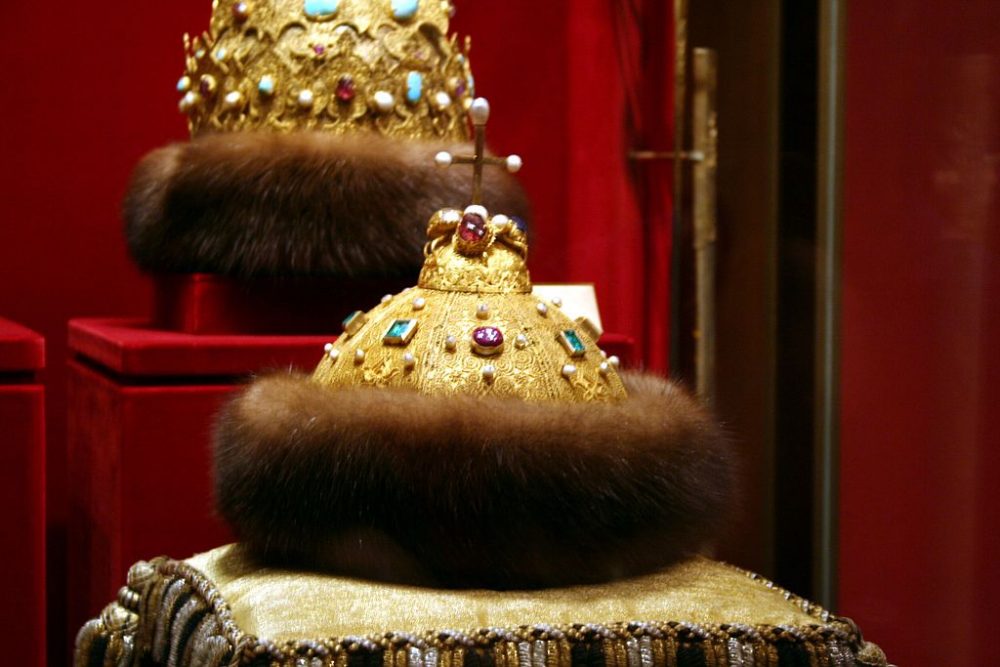
the ‘Monomakh’s Cap’ or Shapka Zolotaya/Golden Cap worn by the Princes of Muscovy.
Doubtless it was by the connections of Estrid ‘Svendsdatter’ that the daughter of King Harold Godwinson, Gytha of Wessex, was betrothed to Volodimyr II “Monomakh” (who took the name “Monomakh” being a relative of Byzantine Emperor Constantine IX Monomachos), of Kyivan Rus who reigned in Kyiv from 1113AD to 1125AD. It is from Volodimyr II that the later Muscovite Crown known as ‘Monomakh’s Cap’ or Shapka Zolotaya/Golden Cap is said to derive by some accounts though it is clearly Asiatic most likely a Mongol headress. It was a productive marriage it seems for five children were born to them including Volodimyr’s successor known as Mstislav the Great or Mstislav I Volodymyrvich the Great of Kyiv. In Norse he is known as ‘Harald’ after his Grandfather Harold Godwinson who died at Hastings but who were kin to the old Viking raider Sweyn, father of Cnut “the Great”. Thus the bloodlines of the old Saxon Godwine’s and the ancestors or Rurik became joined. Mstislav the Great had legitimate claims to the Crown of England potentially.

Grand Prince Mstislav I building the Pyrohoshcha Church.
How they returned to England is a long story but Mstislav married twice. His first Wife (Christina Ingesdotter of Sweden) having died he married again to a local Noble Lady, Ljubava Saviditsch, the daughter of Dmitry Saviditsch, a nobleman of Novgorod. From their union came Euphrosyne of Kyiv who married King Géza II of Hungary and one of their ancestors was Edward III of England, the ‘Yorkist’ King who’s Sister Elizabeth of York, after Edward’s death and his Brother Richard lll’s defeat at Bosworth married Henry Vll and was the Mother of Henry Vlll. Thus the blood of the Rurikids of Kyiv and Novgorod became part of the Royal House of England and thus the descendants of Godwine of Sussex who contributed some ships to “Æthelred the Unready” and who’s son became King of England sought the same sanctury and safety in Kyiv as did the exiled sons of Edmund ‘Ironside’ and both were by twists of fate to return to England and be reunited with the ruling Kings of England.
3. Anglia Orientalis: The ‘New England’ in the East.
The details of this mass exodus of Anglo Saxons which according to some records included “three earls and eight barons” on a fleet numbering 350 ships and who led them are vague. That they ended up in what is today called Muscovite occupied Crimea is provided only by later maps known as “Portolan charts” (literally meaning “related to ports or harbors”) made by navigators of Italy, Spain and Portugal from the 13th to the 16th centuries AD. One of the ports listed in these later maps notes bears the name “Porto di Susacho” which it is said derives from the name Saxon or possibly South Saxon as in “Sussex”. Today this city is known as Novorossiysk in Muscovy close to the Kerch Straits. These later maps also show a “Londina” to the North West of “Susaco” which would presumably be on the coast of Sea of Azov as we call it today. Apparently Londina gave it’s name to a river as well than ran by or through the colony making its most likely location on the northern side of the Sea of Azov, though some claim it was in what we today call occupied Crimea.
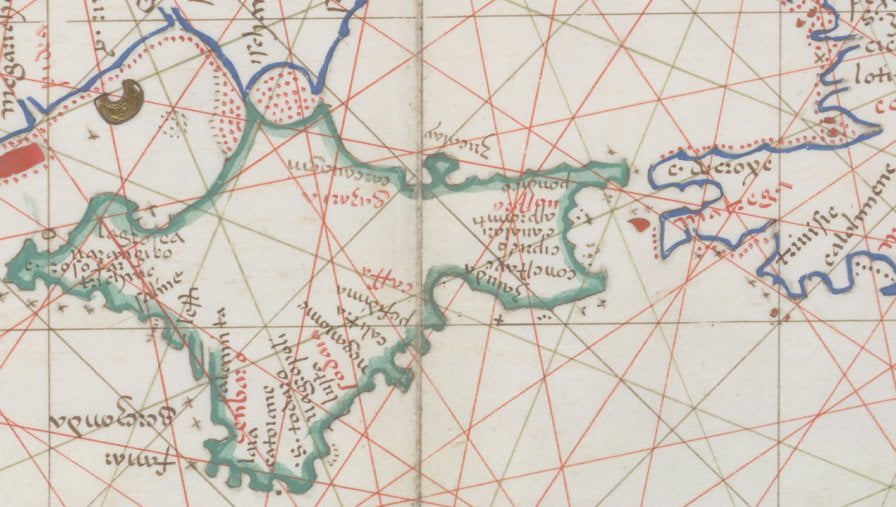
A later Portolan map of Crimea.
It is likely that many Anglo Saxons, including the heirs of King Harold Godwinson, sought help and refuge with Sweyn II of Denmark, the son of Estrid Svendsdatter. Sweyn ll however was unable or unwilling to invade England and passed away in 1076AD having previously seen through the marriage of Gytha of Wessex to to Volodimyr II “Monomakh” of Kyiv as noted above. Sweyn’s Mother Estrid predeceased him and it is possible that with Sweyn’s death many of the old Anglo Saxon nobility who were constantly rebelling against their new Norman overlords felt the last chance of help from the outside against their Norman oppressors was lost. Possibly they also had heard of Harold Godwinson’s daughter’s marriage to a Prince of Kyiv who we know was Volodimyr II “Monomakh”. However in 1075 or 1076, either knowing of the coming death of Sweyn ll (Sveinn Ástríðarson in the Icelandic Sagas) or after it according the Icelandic Sagas this Anglo Saxon fleet left for the Mediterranean and after some adventures arrived in Constinople where the Emperor enlisted some for his Varangian Guard and gave leave to others to settle in the former Byzantine lands on the Black Sea’s northern shore — if they could reconquer them. This by the evidence of the later “Portolan charts” they managed to accomplish creating a small “New England”. If this Anglo Saxon exodus left in 1075/76 Gytha of Wessex would have been Princess of Kyiv when they arrived in Kyivan Rus as she died in 1107AD. It is said that the Anglo Saxon colonists of Kyivan Rus continued to send Christmas Greetings to the Emperor in Constinople in their native Anglo Saxon English tongue until the 14th Century AD. That the Anglo Saxons continued in some part in the service of Emperors is known by an account of the ‘Fourth Crusade’ in 1205 where Geoffrey of Villehardouin (who participated in the ‘Fourth Crusade’ wrote: “The French planted two scaling ladders against a barbican close to the sea. The wall here was strongly manned by Englishmen and Danes, and the struggle that ensued was stiff and hard and fierce.”
There are debates on who lead this expedition (or exodus) of Anglo Saxons East, a “Siward earl of Gloucester” (Sigurðr jarl af Glocestr in the Icelandic sagas) is mentioned and Orderic Vitalis recounts the English fighting for the Emperor Alexius against the Norman Robert Guiscard, Duke of Apulia who’s son Bohemund (later of Antioch) became famous during the First Crusade. That the exodus of the Anglo Saxons at some point is not disputed, when it occured (some say it may have been with Edward “the Exile’s” son Edgar the Ætheling, son of Edward “the Exile” who made his way to the First Crusade. Of the two sources the older Játvarðar Saga (Saga of Edward the Confessor) says:
“Earl Sigurd and the other chiefs begged emperor Alexius to give them some towns and cities which they might own and their heirs after them. The emperor knew of a land north of the sea, which used to be ruled by his predecessors, but had been won by the heathens, who lived there still. The king granted this land to them and their heirs, if they could win it.
Some Englishmen stayed in Miklagarðr [‘the great city,’ i.e., Constantinople], While Earl Sigurd and others sailed north to that land and had many battles there, winning the land and driving away those that lived there before. They called their new land England. Its pre-existing and newly built towns they named after English cities – London, York, and others. The land lies six days and nights sail east and northeast from the City. The English have lived there ever since.”
Again this matches the names of the later Portolan maps placing the English ‘colonies’ around the Black Sea and the Sea of Azov around the time when Gytha of Wessex was Queen/Princess of Kyiv having married Volodimyr II “Monomakh” of Kyiv. Her son, Mstislav I the Great, was doubtless accepted by the Eastern English colonists as their King and perhaps saviour who could restore the old Anglo Saxon rule of England. It was not to happen sadly and the exiles of this voyage married into the local population and are lost. Yet surely the sons and daughters – including Royal sons and daughters of Old Anglo Saxon England walked in what today we call Ukraine including Crimea before any Prince of Muscovy since Moscow did not exist at the time. Whole colonies of exiles settled; “three earls and eight barons” with their families and loyal followers wishing to escape the foreign Norman ‘tyranny’ of William ‘the Conqueror’ (also known as ‘the Bastard’).
That the old Anglo Saxons, Princes, Princesses, Earls and Barons of England looked to Kyiv continually as a place of refuge cannot be denied. It speaks volumes of Kyivan Rus as well that they followed events so far to their West as England and it’s troubled times. Clearly both were closely connected via the Viking/Varangian families that played a part in both countries. The Varangian Norse of Kyivan Rus became absorbed by the native Slavs in the same way as in the end the Norman rulers of England were absorded by the Anglo Saxons. That Kyiv of old was major political force in Europe cannot be denied. It is beyond time that the Kyiv of Ukraine as it is known today retook it’s place at the forefront of European affairs as their ancestors so nobly did in regard to their old English guests who in their times of despair often sought safety in Kyiv by the banks of the Dnieper. Here still lies the reborn free Kyiv today, let us hope our old English friends have not entirely forgotten the Old Ties.
Richard Drozdowski for EMPR
Image credits: na-skryzhalyah
Tags: Culture History Kyivan Rus ukraine front lines

